In late 2022 I attended the European Asbestos Forum conference in Amsterdam. This won’t come as a surprise – I wrote about it shortly afterwards, and anyway I’ve been going since the very first conference. In part inspired by EAF, I’ve regularly talked about how important it is for us to look beyond our shores to find new solutions to old problems.
I’ve also talked about how UK asbestos innovation seemed to stop with the introduction of wet injection. Don’t get me wrong: injection – and the huge safety benefit that comes with removing asbestos that is properly suppressed – was a huge improvement on what went before. But for 20 years we have been resting on our laurels somewhat.
That’s why at EAF 2022 I was so interested in BCL Invent, and their product Easy Gel. In layman’s terms, this is a range of shaped plastic pouches filled with gel. The application that sparked my imagination was for cutting cement pipes, where the pouch is secured to the pipe before being cut through. Rather than just suppressing the dust – which it appeared to do – the gel remained on the surface, forming a barrier – separating the worker from the activity.
This is a crucial consideration if we want to improve safety: how do we separate the worker from the activity? It will become increasingly important as and when the European occupational exposure limit (OEL) is reduced by 10- and 50-fold in the coming years.
BCL Invent’s new approach transformed a very direct and personal activity into one that was significantly more remote. The air test results that they were obtaining were also very impressive; less than 0.0048 fibres per millilitre (f/ml) for cutting a cement pipe and <0.0032f/ml when cutting fibreglass-insulated pipe. I asked myself – how would it perform with the very common challenge in the UK of asbestos-insulated pipes?
Of course, there’s already wrap and cut, a similar method which works as follows:
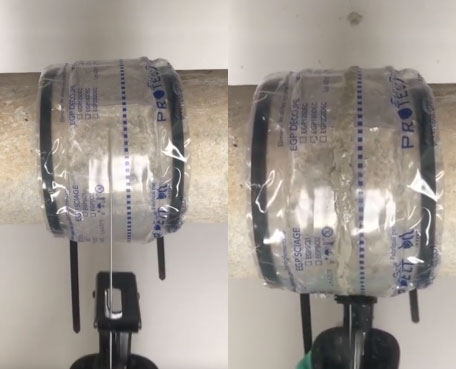
The bare section of pipe is then cleaned, the exposed edges of insulation sealed, and the pipe is cut. The whole process is repeated until the entire pipe has been removed.
Wrap and cut has an advantage over cleaning the whole pipe, as it’s safer: there’s less asbestos disturbance, and it’s quicker so there’s shorter exposure. As a bonus, it’s also cheaper.
It has downsides – in particular vibration and noise. Hand-arm vibration syndrome (HAVS) is particularly challenging. A reciprocating saw is so vibrating that the normal limit per person per day is just 15 minutes. There are also several points in the procedure where we expect the worker to stop, check and repeat. It’s therefore understandable that operatives tend to over-inject, reducing the possibility of coming across dry patches – but dramatically increasing the spread of contaminated water.
Easy Gel seemed much simpler, with very few ‘moving parts’. If its barrier approach worked, it could fall into that sweet spot that the original wrap-and-cut method occupied – safer, quicker and cheaper.
If it works – but who finds out whether it can? The Health and Safety Executive (HSE) doesn’t approve methods: that’s not its job and it never has been. Innovators should be those creating the hazard. But we operate in a fractured industry where licensed contractors have a lot to lose. And we as consultants have become very risk-averse, guilty of blindly applying and enforcing guidance.
Step up BOHS and FAAM, who are in the ideal position to investigate the safety or otherwise of innovative techniques. We designed a rigorous experiment to examine the hypothesis that the use of a barrier gel would be enough to suppress fibre release.
As a control, we first tested the traditional wrap and cut method. Three cuts were made, which took 57 minutes. The results of the two personals for the cutter were both 0.02f/ml.
Here’s a video of the cuts being made…
I intentionally held the video on the last frame with the cut end visible. If we were relying purely on wetting of the insulation – the clear dry spots would have led to significant fibre release. But we didn’t see this.
Five horizontal cuts were made in a 45-minute period using Easy Gel. The results of the two personals for the cutter were 0.02f/ml and 0.04f/ml respectively. The cutter achieved a further four vertical cuts in a 48-minute period. Here the personals were slightly higher at 0.03f/ml and 0.06f/ml.
Our results confirmed that the key quality of the gel-cut method was the formation of a physical barrier, which prevented fibre release. You can see this in this still frame, which shows the extent of (imperfect) wetting from the gel. Were we relying solely on the gel’s wetting properties, this would have resulted in high fibre release.
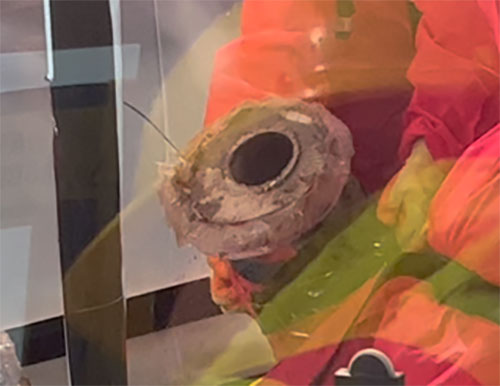
While the individual personal results with gel-cutting were slightly higher, we were able to make cuts more quickly, so total exposure was reduced. Another way to look at this is to ask what would happen if more cuts were made.Twelve cuts using the wrap and cut method would take approximately four hours. The same gel cuts would take less than two. Reducing exposure time by 50% would reduce total exposure.
For this test we also used an ALERT constant monitoring device, and the data we received gave us fascinating insight into the fibre release. We could see the distinct cut points as they happened. The wrap and cut method was particularly interesting – giving us peak exposure after the cuts, not during. You can see this in the chart below, where the pink trace shows fibre levels, and particles are shown in green.
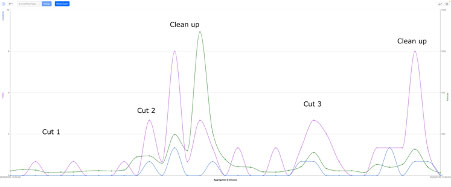
So what did we learn? While the results for vertical cutting with gel packs were still low, it’s slightly more difficult to control than horizontal, so they were slightly higher than the horizontal values.
There’s a more significant, if subtle, difference when it comes to HAVS. With a quicker process, workers could make more cuts in a shift, increasing their exposure to harmful vibration. In addition, the cutting technique required the user to keep the foot plate away from the gel pack to avoid crushing it. This in turn leads to less control and more vibration.
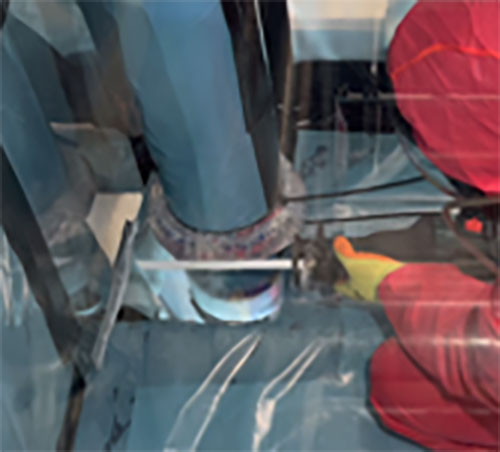
There’s a narrower margin for error with gel cutting – effectively the width of the gel pack, rather than the 150mm you get with the wrap and cut method. When considered with the reduced cutting control, this reduced margin for error might be significant.
The increase of the already significant vibration hazard is particularly problematic for the method and must be addressed before it is used commercially.
We observed comparable air test results: wrap and cut at 0.02f/ml, and gel cut (horizontal) of 0.03f/ml. As wrap and cut resulted in an excess of injection liquid leaking out, gel cutting gave a higher degree of control – there was virtually no spread of contaminated gel.
The gel cut process is much quicker. If 12 horizontal cuts were to be made using the traditional method this would take approximately four hours. Using gel cutting would take approximately half this (meaning the exposure in the subsequent two hours would be zero) . Therefore, whilst the test results are comparable, a total exposure or four-hour time-weighted average (4hrTWA) calculation would be approximately 50% of the wrap and cut equivalent.
This increased efficiency could lead to shorter project duration – which would be commercially attractive to clients and licensed asbestos removal contractors (LARCS).
However, due to the commercially attractive nature of the method, the increased vibration and reduced control must be countered before the procedure is adopted. The following currently available solutions should be considered:
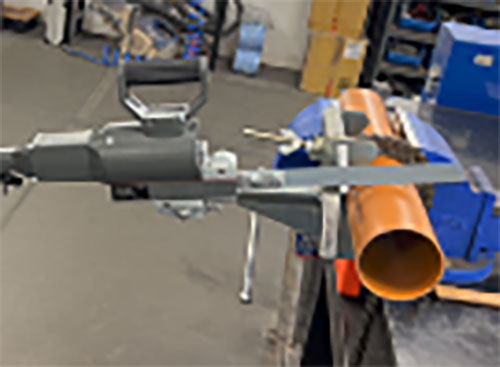
Whilst the picture shows an uninsulated pipe, these devices are equally usable on wrapped insulated pipes. This approach imposes a great deal of control on the cut and virtually eliminates vibration. This modification should be considered for all uses of reciprocating saws, and would be crucial when considering the new method.
This project shows what a fully functioning, joined-up industry can achieve. The innovators must be the hazard creators, but FAAM can provide the structure, independence and academic rigour to prove a method can work.
I’d like to extend our particular thanks to Ben Ives of Horizon Environmental, for tolerating a research project on an asbestos removal project, and to G&L Consultancy for the analytical work. Special thanks also to ALERT for providing the constant monitoring kit, and last but not least BCL, for modifying Easy Gel for the UK application.
Our thanks also go to the site teams:
Horizon Site Team –
Lee Woodward
Jacob Rowley
Jamie Hewings
Matthew Hewings
G&L Site Team
Jim Scholes
Archie Charles
Tweet Share on Facebook Share on Linkedin